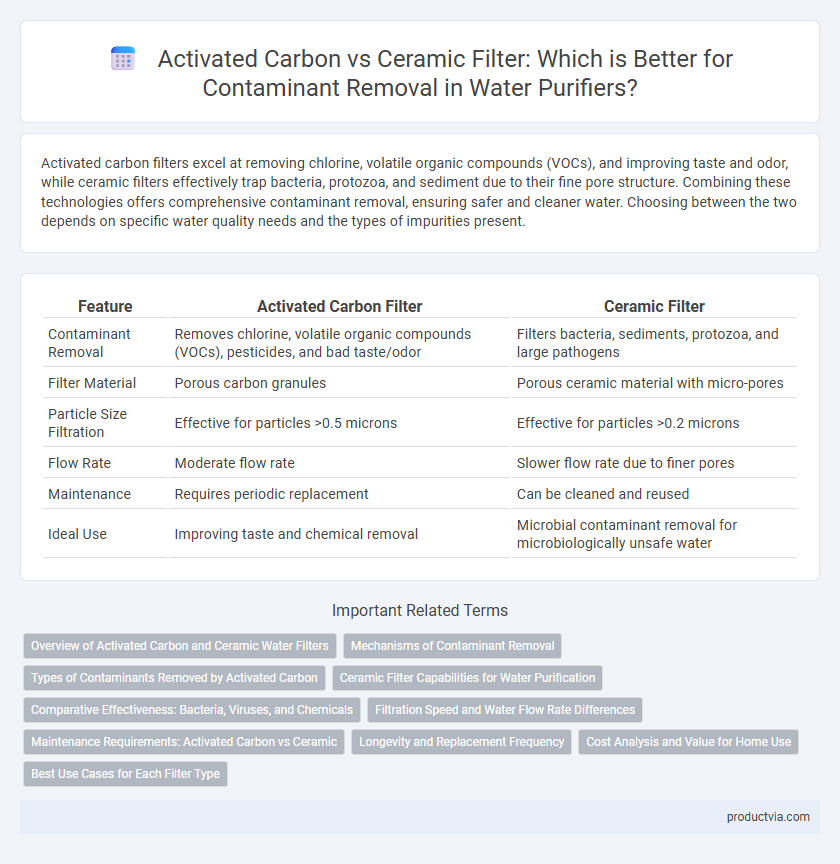Activated carbon filters excel at removing chlorine, volatile organic compounds (VOCs), and improving taste and odor, while ceramic filters effectively trap bacteria, protozoa, and sediment due to their fine pore structure. Combining these technologies offers comprehensive contaminant removal, ensuring safer and cleaner water. Choosing between the two depends on specific water quality needs and the types of impurities present.
Table of Comparison
| Feature | Activated Carbon Filter | Ceramic Filter |
|---|---|---|
| Contaminant Removal | Removes chlorine, volatile organic compounds (VOCs), pesticides, and bad taste/odor | Filters bacteria, sediments, protozoa, and large pathogens |
| Filter Material | Porous carbon granules | Porous ceramic material with micro-pores |
| Particle Size Filtration | Effective for particles >0.5 microns | Effective for particles >0.2 microns |
| Flow Rate | Moderate flow rate | Slower flow rate due to finer pores |
| Maintenance | Requires periodic replacement | Can be cleaned and reused |
| Ideal Use | Improving taste and chemical removal | Microbial contaminant removal for microbiologically unsafe water |
Overview of Activated Carbon and Ceramic Water Filters
Activated carbon filters excel at removing chlorine, volatile organic compounds (VOCs), and unpleasant odors by adsorbing contaminants onto their porous surface. Ceramic filters provide effective mechanical filtration, removing bacteria, protozoa, and sediment with pore sizes typically around 0.2 to 0.5 microns. Both technologies complement each other in water purifiers, combining chemical adsorption and physical barrier mechanisms to ensure cleaner, safer drinking water.
Mechanisms of Contaminant Removal
Activated carbon filters remove contaminants through adsorption, effectively trapping chlorine, volatile organic compounds (VOCs), and certain pesticides by binding them to the porous carbon surface. Ceramic filters eliminate pathogens and particulate matter by physical filtration using their microporous structure, capturing bacteria, protozoa, and sediment typically larger than 0.2 microns. The combined use of activated carbon and ceramic filtration enhances water purification by integrating chemical adsorption with mechanical filtration to tackle a broad spectrum of contaminants.
Types of Contaminants Removed by Activated Carbon
Activated carbon filters excel at removing chlorine, volatile organic compounds (VOCs), pesticides, and unpleasant odors from water, significantly improving taste and safety. They are highly effective in adsorbing chemical contaminants and residual disinfectants but less efficient against microbial pathogens like bacteria and viruses. Compared to ceramic filters, activated carbon specifically targets chemical pollutants rather than particulate or biological contaminants.
Ceramic Filter Capabilities for Water Purification
Ceramic filters excel in removing bacteria, protozoa, and sediments from water through their fine porous structure, which typically ranges between 0.5 to 1 micron in pore size. Unlike activated carbon filters that primarily adsorb chlorine, odors, and organic chemicals, ceramic filters provide physical barriers to pathogens, making them highly effective against microbial contamination. Their durability and ability to be cleaned and reused contribute to sustained water purification performance without the need for frequent replacements.
Comparative Effectiveness: Bacteria, Viruses, and Chemicals
Activated carbon filters excel in removing chemicals, chlorine, and organic compounds, significantly improving taste and odor but have limited efficacy against bacteria and viruses. Ceramic filters feature microporous structures that effectively block bacteria and protozoa but are less efficient at filtering viruses and chemical contaminants. For comprehensive contaminant removal, combining activated carbon with ceramic filtration offers enhanced protection against bacteria, viruses, and chemical pollutants.
Filtration Speed and Water Flow Rate Differences
Activated carbon filters offer rapid filtration speed with a high water flow rate, efficiently removing chlorine, volatile organic compounds (VOCs), and certain heavy metals. Ceramic filters, while slower due to their microscopic pores, excel in trapping bacteria, protozoa, and sediment but typically reduce water flow rate. Choosing between the two depends on the filtration priority: faster flow for chemical contaminants favors activated carbon, whereas microbial safety with slower flow points to ceramic filters.
Maintenance Requirements: Activated Carbon vs Ceramic
Activated carbon filters require frequent replacement, typically every 3 to 6 months, due to saturation with contaminants, while ceramic filters can be cleaned and reused multiple times before replacement is necessary. Ceramic filters need regular scrubbing to prevent clogging and maintain flow rate but generally offer a longer lifespan compared to activated carbon cartridges. Maintenance frequency and method vary significantly, impacting the overall cost-effectiveness and convenience of water purification systems using these technologies.
Longevity and Replacement Frequency
Activated carbon filters excel in removing chlorine, pesticides, and organic compounds but tend to have a shorter lifespan of 3 to 6 months, requiring more frequent replacements to maintain optimal contaminant removal. Ceramic filters offer longer durability, often lasting 6 to 12 months, effectively eliminating bacteria and sediments with minimal replacement frequency. Choosing between them depends on water quality and maintenance willingness, balancing activated carbon's superior chemical filtration against ceramic's extended longevity.
Cost Analysis and Value for Home Use
Activated carbon filters generally offer lower upfront costs and effective removal of chlorine, VOCs, and odors, making them cost-efficient for everyday home use. Ceramic filters, while typically more expensive initially, provide long-lasting performance and superior removal of bacteria and sediment, leading to fewer replacements and better long-term value. Evaluating household water quality and budget constraints helps determine the most cost-effective choice between activated carbon and ceramic filters for contaminant removal.
Best Use Cases for Each Filter Type
Activated carbon filters excel in removing chlorine, volatile organic compounds (VOCs), and improving taste and odor, making them ideal for urban areas with chemical contaminants. Ceramic filters effectively remove bacteria, protozoa, and sediments, suitable for rural or outdoor use where microbial contamination is prevalent. Combining both filters provides comprehensive water purification for diverse contaminant profiles.
Activated Carbon vs Ceramic Filter for contaminant removal Infographic

 productvia.com
productvia.com